公示语汉英翻译
- 格式:pptx
- 大小:2.81 MB
- 文档页数:19
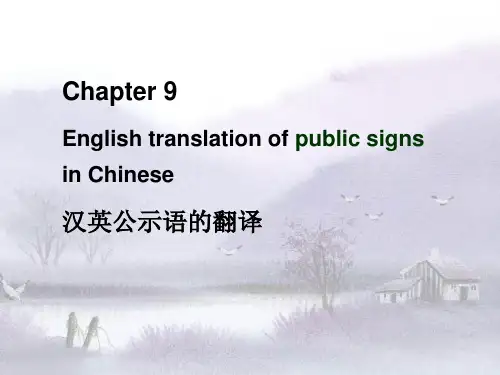
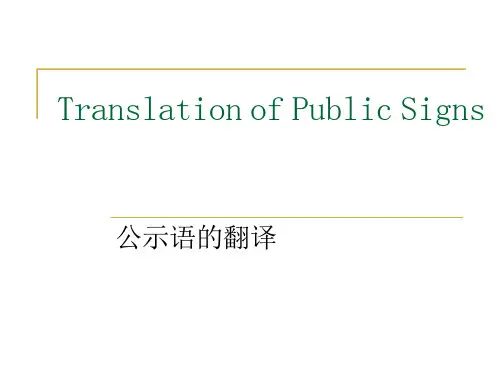
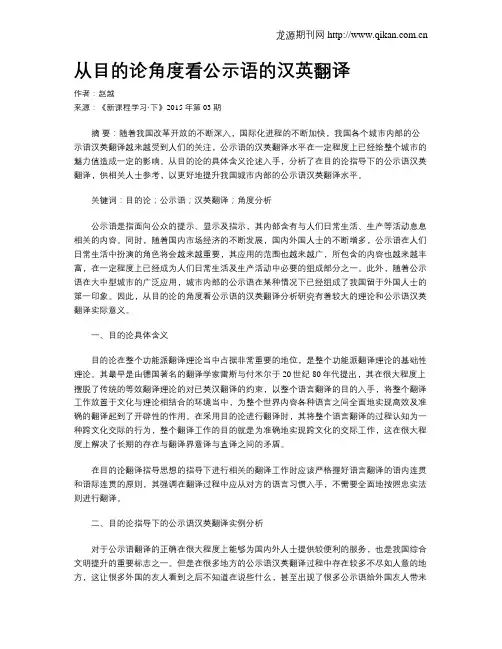
从目的论角度看公示语的汉英翻译作者:赵越来源:《新课程学习·下》2015年第03期摘要:随着我国改革开放的不断深入,国际化进程的不断加快,我国各个城市内部的公示语汉英翻译越来越受到人们的关注,公示语的汉英翻译水平在一定程度上已经给整个城市的魅力值造成一定的影响。
从目的论的具体含义论述入手,分析了在目的论指导下的公示语汉英翻译,供相关人士参考,以更好地提升我国城市内部的公示语汉英翻译水平。
关键词:目的论;公示语;汉英翻译;角度分析公示语是指面向公众的提示、显示及指示,其内部含有与人们日常生活、生产等活动息息相关的内容。
同时,随着国内市场经济的不断发展,国内外国人士的不断增多,公示语在人们日常生活中扮演的角色将会越来越重要,其应用的范围也越来越广,所包含的内容也越来越丰富,在一定程度上已经成为人们日常生活及生产活动中必要的组成部分之一。
此外,随着公示语在大中型城市的广泛应用,城市内部的公示语在某种情况下已经组成了我国留于外国人士的第一印象。
因此,从目的论的角度看公示语的汉英翻译分析研究有着较大的理论和公示语汉英翻译实际意义。
一、目的论具体含义目的论在整个功能派翻译理论当中占据非常重要的地位,是整个功能派翻译理论的基础性理论。
其最早是由德国著名的翻译学家雷斯与付米尔于20世纪80年代提出,其在很大程度上摆脱了传统的等效翻译理论的对已英汉翻译的约束,以整个语言翻译的目的入手,将整个翻译工作放置于文化与理论相结合的环境当中,为整个世界内容各种语言之间全面地实现高效及准确的翻译起到了开辟性的作用。
在采用目的论进行翻译时,其将整个语言翻译的过程认知为一种跨文化交际的行为,整个翻译工作的目的就是为准确地实现跨文化的交际工作,这在很大程度上解决了长期的存在与翻译界意译与直译之间的矛盾。
在目的论翻译指导思想的指导下进行相关的翻译工作时应该严格握好语言翻译的语内连贯和语际连贯的原则,其强调在翻译过程中应从对方的语言习惯入手,不需要全面地按照忠实法则进行翻译。
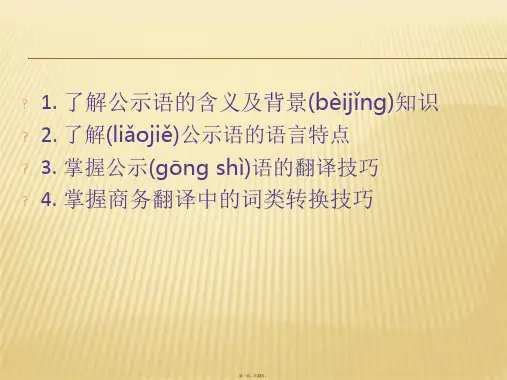
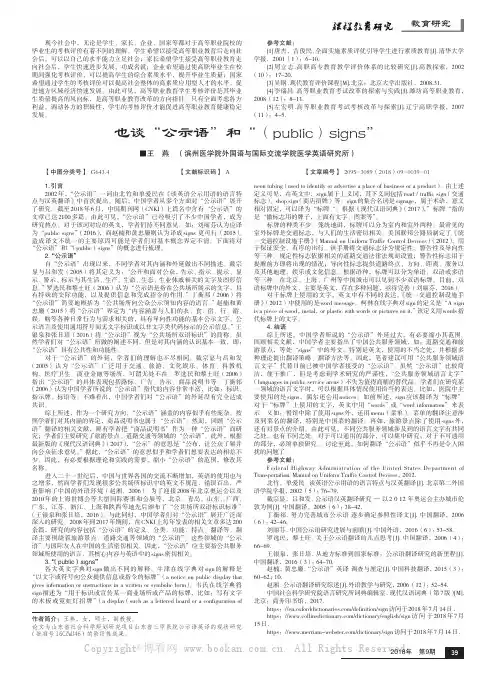
教育研究现今社会中,无论是学生、家长、企业、国家等都对于高等职业院校的毕业生的考核评价有着不同的理解。
学生希望以接受高等职业教育后走向社会后,可以以自己的水平能力立足社会;家长希望学生接受高等职业教育走向社会后,学生快速进步发展,功成名就;企业希望通过使高职毕业生在校期间强化考核评价,可以提高学生的综合素质水平,提升毕业生质量;国家希望通过学生的考核评价可以提高社会整体的高素质应用型人才的水平,促进地方区域经济快速发展。
由此可见,高等职业教育学生考核评价是其毕业生质量提高的风向标,是高等职业教育改革的方向指针。
只有全面考虑各方利益,调动各方的积极性,学生的考核评价才能促进高等职业教育健康稳定发展。
参考文献:[1]唐杰,吉俊民.全面实施素质评优引导学生进行素质教育[J].清华大学学报,2001(1):6-10.[2]周立志.高职高专教育教学评价体系的比较研究[J].高教探索,2002(10):17-20.[3]吴钢.现代教育评价课程[M].北京:北京大学出版社,2008.31.[4]李瑞昌.高等职业教育考试改革的探索与实践[J].潍坊高等职业教育,2008(12):8-11.[5]左宏明.高等职业教育考试考核改革与探索[J].辽宁高职学报,2007(11):4-5.1.引言2002年,“公示语”一词由北竹和单爱民在《谈英语公示用语的语言特点与汉英翻译》中首次提出。
随后,中国学者从多个方面对“公示语”展开了研究。
截至2018年6月,中国期刊网(CNKI)上篇名中含有“公示语”的文章已达2100多篇。
由此可见,“公示语”已经吸引了不少中国学者,成为研究热点。
对于该词对应的英文,学者们持不同意见。
如:刘丽芬认为应译为“public signs”(2016),而赵楠和黄忠廉则认为译成signs 更可行(2015)。
造成译文不统一的主要原因可能是学者们对基本概念界定不清。
下面将对“公示语”和“(public)signs”的概念进行梳理。
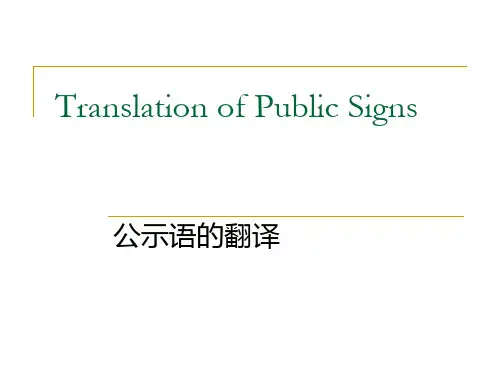
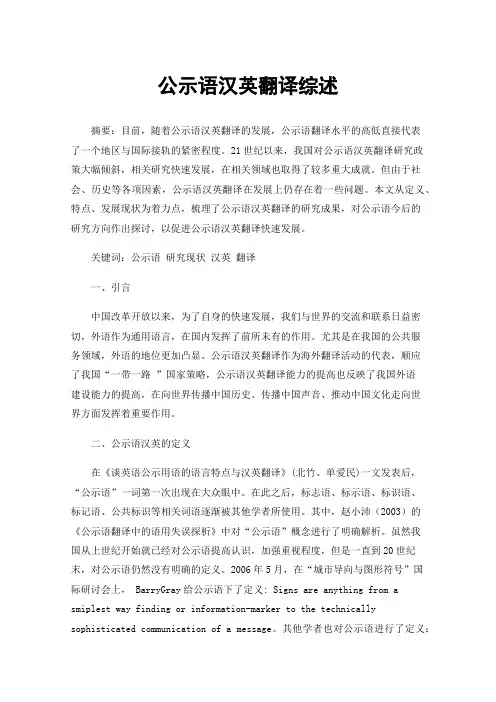
公示语汉英翻译综述摘要:目前,随着公示语汉英翻译的发展,公示语翻译水平的高低直接代表了一个地区与国际接轨的紧密程度。
21世纪以来,我国对公示语汉英翻译研究政策大幅倾斜,相关研究快速发展,在相关领域也取得了较多重大成就。
但由于社会、历史等各项因素,公示语汉英翻译在发展上仍存在着一些问题。
本文从定义、特点、发展现状为着力点,梳理了公示语汉英翻译的研究成果,对公示语今后的研究方向作出探讨,以促进公示语汉英翻译快速发展。
关键词:公示语研究现状汉英翻译一、引言中国改革开放以来,为了自身的快速发展,我们与世界的交流和联系日益密切,外语作为通用语言,在国内发挥了前所未有的作用。
尤其是在我国的公共服务领域,外语的地位更加凸显。
公示语汉英翻译作为海外翻译活动的代表,顺应了我国“一带一路”国家策略,公示语汉英翻译能力的提高也反映了我国外语建设能力的提高,在向世界传播中国历史、传播中国声音、推动中国文化走向世界方面发挥着重要作用。
二、公示语汉英的定义在《谈英语公示用语的语言特点与汉英翻译》(北竹、单爱民)一文发表后,“公示语”一词第一次出现在大众眼中。
在此之后,标志语、标示语、标识语、标记语、公共标识等相关词语逐渐被其他学者所使用。
其中,赵小沛(2003)的《公示语翻译中的语用失误探析》中对“公示语”概念进行了明确解析。
虽然我国从上世纪开始就已经对公示语提高认识,加强重视程度,但是一直到20世纪末,对公示语仍然没有明确的定义。
2006年5月,在“城市导向与图形符号”国际研讨会上, BarryGray给公示语下了定义: Signs are anything from a smiplest way finding or information-marker to the technically sophisticated communication of a message。
其他学者也对公示语进行了定义:丁衡祁(2006)认为“公示语是在公共场合向公众公示须知内容的语言,它包括标识、指示牌、路牌、标语、公告、提示语等”。
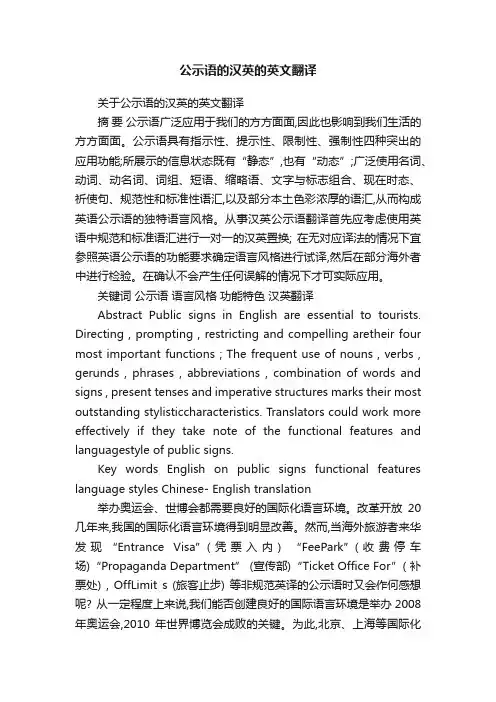
公示语的汉英的英文翻译关于公示语的汉英的英文翻译摘要公示语广泛应用于我们的方方面面,因此也影响到我们生活的方方面面。
公示语具有指示性、提示性、限制性、强制性四种突出的应用功能;所展示的信息状态既有“静态”,也有“动态”;广泛使用名词、动词、动名词、词组、短语、缩略语、文字与标志组合、现在时态、祈使句、规范性和标准性语汇,以及部分本土色彩浓厚的语汇,从而构成英语公示语的独特语言风格。
从事汉英公示语翻译首先应考虑使用英语中规范和标准语汇进行一对一的汉英置换; 在无对应译法的情况下宜参照英语公示语的功能要求确定语言风格进行试译,然后在部分海外者中进行检验。
在确认不会产生任何误解的情况下才可实际应用。
关键词公示语语言风格功能特色汉英翻译Abstract Public signs in English are essential to tourists. Directing , prompting , restricting and compelling aretheir four most important functions ; The frequent use of nouns , verbs , gerunds , phrases , abbreviations , combination of words and signs , present tenses and imperative structures marks their most outstanding stylisticcharacteristics. Translators could work more effectively if they take note of the functional features and languagestyle of public signs.Key words English on public signs functional features language styles Chinese- English translation举办奥运会、世博会都需要良好的国际化语言环境。

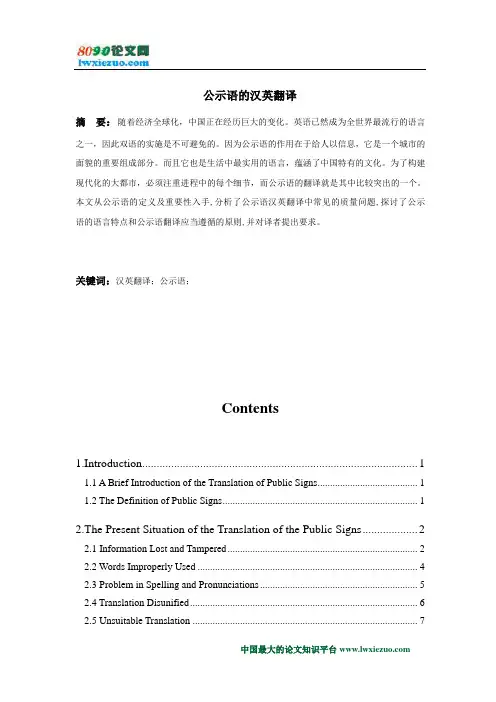
公示语的汉英翻译摘要:随着经济全球化,中国正在经历巨大的变化。
英语已然成为全世界最流行的语言之一,因此双语的实施是不可避免的。
因为公示语的作用在于给人以信息,它是一个城市的面貌的重要组成部分。
而且它也是生活中最实用的语言,蕴涵了中国特有的文化。
为了构建现代化的大都市,必须注重进程中的每个细节,而公示语的翻译就是其中比较突出的一个。
本文从公示语的定义及重要性入手,分析了公示语汉英翻译中常见的质量问题,探讨了公示语的语言特点和公示语翻译应当遵循的原则,并对译者提出要求。
关键词:汉英翻译;公示语;Contents1.Introduction (1)1.1 A Brief Introduction of the Translation of Public Signs (1)1.2 The Definition of Public Signs (1)2.The Present Situation of the Translation of the Public Signs (2)2.1 Information Lost and Tampered (2)2.2 Words Improperly Used (4)2.3 Problem in Spelling and Pronunciations (5)2.4 Translation Disunified (6)2.5 Unsuitable Translation (7)3.Methods to Assess the Quality of Translation of Public Signs (8)3.1 From the Aspect of the Applied and Indicated Function (8)3.1.1 Informational Function (8)3.1.2 Instructive Function (8)3.1.3 Regulatory Function (8)3.1.4 Warning Function (9)3.2 According to the Standard Issued by the State (10)3.3 Taking the Traditional Translation into Consideration (11)4.Methods Employed in Public Signs Translation (12)4.1 Literal Translation (12)4.2 Semantic Translation (13)4.3 Adaptation (14)5.Some Recommendations (15)6.Conclusion (17)1. Introduction1.1 A Brief Introduction of the Translation of Public SignsThe errors in C-E sign translation have drawn much attention of the public and the experts in this field. As a result, academic research and public campaigns on C-E sign translation are prevailing now. With the first national seminar on translation of public sings being held by the China Translation Association on the International Translation Day in 2005, the translation of public signs has been on the agenda of the construction of a modernization China. On the seminar, experts on the translation of public signs, points out that, the use of language in a country implicates the culture of that nation; on the process of constructing a harmonious society, all kinds of improper use of our mother tongue and foreign languages is inharmonic with that theme.A lot of errors were found and have been put into process, changed or unified, however, it is even until now—two years after the first nation seminar, the situation is not so positive. The translation of public signs is still far from perfect, even in world-famous metropolis as Beijing and Shanghai. This not only gives a negative impression on our foreign friends, but also is baneful to the development of our economy and culture and the gradually increase of foreign-oriented communication. 1.2 The Definition of Public SignsAccording to Oxford English Dictionary, sign refers to a characteristic device attached to, or placed infront of,an inn or a store,as a means of distinguishing it from others or direct attention to it.Public signs include marker, pointer, guide post, catchline, pronunciamento, warning and so on. Sometimes it is also called the environmental communication notices and signs (Ding Hengqi, 2006).The Chinese name of public places mainly refers to name of certain places and public places, such as public service establishments, public cultural and sports places, tourist scenic spots, national exhibitions and large activities, the office for the national department and so on (Xu Jian,2006) .While in English, there are many classifications for public signs and each of themwith a special name. For example, public signs in public buildings are called environmental communication signages, which mainly refer to the way-finding directional signs (Ding Hengqi, 2006). The signs in sight-seeing spots are certainly an important aspect of the public signs and they belong to environmental communication. The informational instructions on foods, medicine, cosmetics are also one kind of public signs, the instructional notices. English has a really long history for bilingual or multilingual public signs study, so it has been developed in a complete way, while in China, in such a short time, we can not make thorough development. The Chinese public signs are somehow different from their English counterparts and have their own characteristics.2. The Present Situation of the Translation of the Public SignsThough we have carried out the policy of reform and opening up to the outside world for many years, the history of bilingual public signs is of certain limitation. Some cities adopt the double language of public signs in the purpose of giving convenience and connecting China with the world. Each city has their own kinds of translation and then uses it in a rather proud way of being the first group of cities walking before the big tide of double-language.However, for various kinds of reasons, the status quo of the translation of the public signs is not so positive.As media takes part in, more versions of translations have come out, unfortunately without unification. While concerning this problem, it can be divided into several classifications as following:2.1 Information Lost and TamperedInformation lost and tampered is a big problem in the translation of public signs. To explain this category, some specific examples are illustrated. Please look at the following examples:Example A: “Passengers, stop here.”“Guests go no further.”“Guests, stop here.”“Tourists stop here.”From the translation of public signs above, as Chinese, we have no difficulty in guessing the meaning this sign wants to express originally. That is “Staff Only”(LuHefa & Shan Lipin, 2004) in English and “游客止步”in Chinese. All the text of the translation mentioned above is quoted from some tourist spots. It is no doubt that such series of translation will actually cause more or less misunderstanding and raise discussion. Many of them adopt the literal translation skills and put it in a rather stiff way. And one of the big problems is that it neglects the culture: this public signs already have their counterparts in English. As to such a matter, it is better to use the relative and idiomatic way to express it.Example B: “Shanghai Swimming Pool” , “Shanghai Swimming Center” and “Shanghai Swimming Gym”, which is better for the translation of “上海游泳馆”?“Pool” usually means:(1) a small and rather deep body of usually fresh water;(2) a quiet place in a stream;(3) a body of water forming above a dam (Webster’s Dictionary).“Center”here is given the meaning of a group of the same things that come together and combined to a big one.While gym is the abbreviation of gymnasium:(1) a large room used for various indoor sports (as basketball or boxing) andusually equipped with gymnastic apparatus;(2) a building (as on a college campus) containing space and equipment forvarious indoor sports activities and usually including spectator accommodations, locker and shower rooms, offices, classrooms, and a swimming pool (Websters’) .It seems that all these words can be combined with “swimming”, but the meaning is different. “Swimming pool”usually refers to one pool and it is used to describe those outdoor ones; while “swimming center” often takes up the center of that place and is the biggest one and sometimes even the unique one in that area. “Swimming gym”is comparatively common and it is more sports-oriented and always inside a building.As a matter of fact, the “上海游泳馆” contains more than one swimming pool andis a building with roof. It is also equipped with many training devices with the special training course carried out daily. Seen from the explanations mentioned above, the “上海游泳馆” actually should be translated into “Shanghai Swimming Gym”.This category of mistakes usually results in the misunderstanding or semi-understanding of the word and the culture of English. Like Chinese, English is full of synonyms. Though they are similar with each other in meaning, they are still different under certain circumstance, expressing the different meaning. Small differences should be paid great attention to, otherwise, mistake will occur and information be lost or tampered.2.2 Words Improperly UsedAll the translation context are translated by translators or interpreters, while their acquired English is of various levels, so the translation will no wonder fall into various category. The improper use of words is unavoidable. And we can see this kind of mistake in many places.The most common one is the translation of the residence of a community. In China, people tend to use “**花园,**新村,**村”to describe a residence of a group of people. For example, the translation of “美政花园”is “Meizheng Garden”on the guidepost along Fuxing Road in Hangzhou. Here “花园” indicates the place for living. But what is “Garden”to English-speakers? According to Merriam-Webster on line dictionary, the explanation is as following:(1)a: a plot of ground where herbs, fruits, flowers, or vegetables arecultivatedb: a rich well-cultivated regionc : a container (as a window box) planted with usually a variety of smallplants(2) a: a public recreation area or park usually ornamented with plants and treesb: an open-air eating or drinking placec: a large hall for public entertainment(Webster’s)To conclude, “Garden”is a place with plants and is created for relaxation and entertainment. So when English-speakers see the guidepost and go into the “garden”with the purpose of having some scenery to view or some relax, but only to find some tall buildings disappointedly and embarrassedly.Another example is the “市北新工业区”. The translation is “Shibei Industry New Zone”. When seeing this translation, we will wonder where “Shibei” is. It’s no doubt that this will cause a big laugh when we see the Chinese. Beside, this translation has another problem: the translation seems to be very coherence with the Chinese letter, even the order of the word. Actually it’s wrong. According to the usage of English word, the adjective “New” should be put above all other adjectives (Bao Bing, 2002). Therefore, the right translation should be “Shanghai Northern New Industry Zone”.2.3 Problem in Spelling and PronunciationsThe problem in spelling and pronunciation is very common in public sign translation. As we know, spelling and pronunciation is the most basic skills of English. But the translation of public signs in some places unfortunately manifests the qualification of the translator’s English. The spelling problem contains the mistake of followings:1) Wrong spelling“No smoking” and “No Park” is possibly due to the carelessness of the translator. The correct writing should be “ No Smoking” and “No Parking”.2) Capitalized wordsIn the display of place name, the capitalized words are used in a very common way. We can see every road on the guidepost begins with a capitalized letter. But unfortunately, many are wrongly written, especially on the screen of the public transportation in Shanghai. There’s a screen on every bus or subway that shows the name of the stop. And the mistake of capitalized mistake is unified in a surprising way—mistake all in one way, “South Hong Mei Road”, “Yan Chang Road”, “Gui Lin Newly State” and so on. According to the convention of translation of roads issued in 2005, name of roads should be written in a formal way, with the first letter of the proper noun(Xu Jian, 2006) capitalized and other using small letters. So the correct spelling should be “South Hongmei Road”, “Yanchang Road”and “Guilin Newly State” .3) PronunciationThe pronunciation of the transportation is newly appeared in the major cities of China. It is carried out to give convenience to English-speakers. But as a matter of fact, the pronunciations on buses or subways are not very clear, especially in Hangzhou, so it is not an easy work to understand them. Methods should be adopted to solve this problem.Besides, there’s another problem of pronunciation, using American English or British English. British English is standard English according to the history of English, however as centuries pass, American English now has become more popular and used more widely. So when announced in the bus or subway, the name of the bus stop should adopt which version of English is actually a difficult choice. .Further more, the pronunciation should be paid great attention to. In the Y5 bus in Hangzhou, it can be clearly noticed that the announcer pronounce the “r” as “l”. And intonation is a big problem as well.2.4 Translation DisunifiedThe disunification here refers to the translation of the same place or of the same place name in different way and the different translation of the same Chinese character with the same meaning.1) Same place name with different translation versionDifferent buses have different translation versions for the same bus stop, not even take that of the subway into consideration. For example, in Shanghai, there are many bus stops before “上海植物园”. While the author rides on different bus, two kinds of pronunciations are heard “Shanghai Botanic Garden”and “Shanghai A rboretum”. These two kinds of translation are all correct and suitable but there’s only one problem: the name place is unique when it refers to the specific ones. Try to imagine, if two foreigners talk about this place, one with the translation of “Shanghai Botanic Garden”, while the other uses another one. What an embarrassing situation it was.2) Same common noun with different translation versionHere the same common noun is the noun commonly used in place name, referring to things of the same kind and the special one of this kind, such as the “station”“airport” and so on (Xu Jian, 2006) . This kind of translation should be unified in the whole city, the whole country and even the world as a whole. While the author discover that this aspect of translation is really terrible to some extent. Take “新村” for example. In Hangzhou, the translation of “闸弄口新村”is “Zha Nong Kou Community ” but “田林新村” in Shanghai is “Tianlin Newly Estate”. “新村” is shown in the same characters and means the same in China, but why the translation of the two characters are totally different. This kind of translation should be put into unity and convention.3) Differences in writing and pronunciationThe author also discovers that some place are written in one way on the bus stop post and the digital screen in the bus, but announced in another way. For example, “田林十一村” in Shanghai is written “Tian Lin No.11 Newly State” while is broadcast in “11th Tianlin Newly State”. Though it is just a small problem and can be understood to some extent. Any way, this disunity should also be emphasized in the progress to contribute a perfect image of a civilized city.2.5 Unsuitable TranslationHere unsuitable translation refers to those that need translation are not translated and vice versa.Many public signs are not translated, like many public signs in the subway of Shanghai. Shanghai is a very common place for foreigners to go, visit or invest. And the subway is somehow a very important transportation means. “老,孕,病,残专座”should be translated out, “please offer this seat to elderly or disabled people or those carrying children”; “get off first” for “先下后上”; “get-on district” for “上客区” and “get-off district” for “下客区”.The expression of some public signs is very particular and exclusive in China. They illustrate the fascination or the dark aspect of China to which there’s no need to translate to show to our foreign counterparts (Luo Xuanmin & Li Tuwang, 2006). Take “No pee here” for an example. This public sign is embarrassed and only indicates the impoliteness of Chinese, which will leave a negative impression to those foreign visitors in the scenery spot. Therefore, it is better not to translate this kind of publicsigns.3. Methods to Assess the Quality of Translation of Public SignsThe author has pointed out several categories of mistake. So what is the standard the author takes to assess those translations? The standards are illustrated as the followings:3.1 From the Aspect of the Applied and Indicated FunctionAs the public signs is used in every aspect of our daily life and does direct impact on our life, the translation of public signs is based on the acknowledgement of the applied and indicated functions of them. The most important ones are informational function, instructive function, regulatory function and warning function (Stuart Redman, 2002). The different functions of the public signs directly affect the style and the mood of the translation.3.1.1 Informational FunctionInformational function refers to the service of the information, without any limited or compellent meaning. It is to provide some information to better the service towards the aimed group of people. Its function is to indicate the context of the service, for example: “Information”for “问询”, “Car Rental ” for “租车”, “Travel Service”for “旅游服务” and “Take away” for “外卖”。
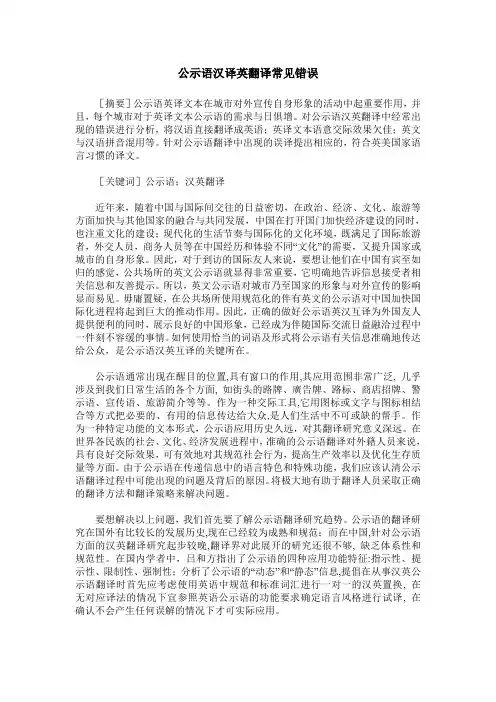
公示语汉译英翻译常见错误[摘要]公示语英译文本在城市对外宣传自身形象的活动中起重要作用,并且,每个城市对于英译文本公示语的需求与日俱增。
对公示语汉英翻译中经常出现的错误进行分析,将汉语直接翻译成英语;英译文本语意交际效果欠佳;英文与汉语拼音混用等。
针对公示语翻译中出现的误译提出相应的,符合英美国家语言习惯的译文。
[关键词]公示语;汉英翻译近年来,随着中国与国际间交往的日益密切,在政治、经济、文化、旅游等方面加快与其他国家的融合与共同发展,中国在打开国门加快经济建设的同时,也注重文化的建设;现代化的生活节奏与国际化的文化环境,既满足了国际旅游者,外交人员,商务人员等在中国经历和体验不同“文化”的需要,又提升国家或城市的自身形象。
因此,对于到访的国际友人来说,要想让他们在中国有宾至如归的感觉,公共场所的英文公示语就显得非常重要,它明确地告诉信息接受者相关信息和友善提示。
所以,英文公示语对城市乃至国家的形象与对外宣传的影响显而易见。
毋庸置疑,在公共场所使用规范化的伴有英文的公示语对中国加快国际化进程将起到巨大的推动作用。
因此,正确的做好公示语英汉互译为外国友人提供便利的同时,展示良好的中国形象,已经成为伴随国际交流日益融洽过程中一件刻不容缓的事情。
如何使用恰当的词语及形式将公示语有关信息准确地传达给公众,是公示语汉英互译的关键所在。
公示语通常出现在醒目的位置,具有窗口的作用,其应用范围非常广泛, 几乎涉及到我们日常生活的各个方面, 如街头的路牌、廣告牌、路标、商店招牌、警示语、宣传语、旅游简介等等。
作为一种交际工具,它用图标或文字与图标相结合等方式把必要的、有用的信息传达给大众,是人们生活中不可或缺的帮手。
作为一种特定功能的文本形式,公示语应用历史久远,对其翻译研究意义深远。
在世界各民族的社会、文化、经济发展进程中,准确的公示语翻译对外籍人员来说,具有良好交际效果,可有效地对其规范社会行为,提高生产效率以及优化生存质量等方面。
公示语汉英翻译的交际翻译策略作者:王星来源:《青年文学家》2010年第09期1、引言“公示语——公开和面对公众,告示、指示、提示、显示、警示、标示与其生活、生产、生命、生态、生业休戚相关的文字及图形信息。
”英语作为国际化的强势语言,在维系国际交流上起到了举足轻重的作用,所以国内对公示语汉英翻译的研究也是不胜枚举。
“随着上海世博会和广州亚运会的筹办工作的进行,新一轮对公示语翻译的正确与规范研究又成为这种国际化大环境建设中的热点,引起了译界的广泛关注”2、徐州公示语汉英翻译现状“由于公示语在公众和旅游者生活中的重要作用。
对公示语的任何歧义、误解、滥用都会导致不良后果。
只有认真探讨英语公示语的功能意义和语言风格,才能真正准确发挥英语公示语在我国深化改革,扩大开放,城市国际化进程中的积极作用。
”徐州处于苏鲁豫皖四省交接处,是苏北最大城市,全国重要的交通和铁路枢纽,能源基地,向来为兵家必争之战略要地和商贾云集中心,文化悠久,同时也是江苏省重点规划建设的三大都市圈核心城市和四个特大城市之一。
翻译清晰、得体的公示语可以为来徐的客人们提供极大的便利,同时也能够提高徐州的整体形象。
请看下面两个例子:禁止使用闪光灯:Don’t you photo flash lamp,请勿触摸:No touch please,这是在徐州博物馆内的两则公示语,第一则翻译让人迷惑不解,语法错误,而且名词、动词的用法混淆,用“NO FlashLamp Please”简洁明了,又能达到禁止的效果。
“No touchplease”,看似礼貌而又规范,实则这其中的“touch”一词犯了动词、名词混淆的错误,"No”后面可以加名词,但“touch”作为名词使用时,作“触觉,润色、装点、装饰”解,并没有触摸的意思。
笔者认为应改为“№Touching Please”。
这是不规范公示语汉英翻译的两个小例子,徐州博物馆是外宾必访的旅游景点,这样的低级错误,实在是不能理解。
C- E Translation Principles of Public Signs 汉英公示语的翻译原则ReferenceExercise 11. 请勿疲劳驾驶Stay alert,stay alive.2. 搜品廊Shopping Land3. 宾客止步Staff only4.不可回收Non-recyclable5. 请勿触摸Hands Off6.禁止停车No Parking7.公交车专用Buses OnlyExercise 21.南宁是我家,卫生靠大家。
参考译文: Keep our city clean.2.不准乱扔烟头参考译文: No Cigarette Disposal3.无障碍专用通道参考译文: Wheelchair Accessible4.机房重地,非公莫入参考译文: Machine Room Staff OnlyExercise 31.一看二慢三通过参考译文: Slow down, look around, and cross.2.桂林山水甲天下参考译文: East or west, Guiling landscape is the best.3.五讲四美三热爱参考译文: Five Stresses,Four Points of Beauty and Three Aspects of Love.(stress on decorum,manners,hygiene,discipline and morals;beauty of the mind,language,behavior and the environment;love of the motherland,socialism and the Communist Party.)4.来也匆匆去也冲冲参考译文: Come with a rush? Go with a flush!Please flush after you’re through.5.老、弱、病、残、孕专座参考译文: Courtesy Seat。
“目的论”视角下的公示语汉英翻译公示语,即为“公开和面对公众,告示、指示、提示、显示、警示、标示与其生活、生产、生命、生态、生业休戚相关的文字及图形信息”(吕和发:2004)。
北京奥运会、上海世博会和广州亚运会成功召开之后,我国对外开放程度越来越高,境内外人员交往越来越密切,从而,公共场合中英双语公示语也越来越有必要。
然而,尽管公示语汉英翻译问题早在十年前就引起了社会的关注,但是经过十年的发展,该领域翻译现状仍然不容乐观。
我试运用“翻译目的论”理论,主要以南京地铁内公示语为例,分析公示语的汉英翻译。
一、“翻译目的论”简介由弗米尔(Vermeer)和诺德(Nord)倡导的“翻译目的论”认为翻译是以原文为基础的有目的和有结果的行为,必须遵循三条法则――目的法则、连贯法则和忠实法则,其中目的法则居于首位,连贯法则和忠实法则居于从属地位,也就是说译者应该根据翻译目的采用翻译策略,有权根据目的决定保留、调整或修改原文内容。
“目的论”一个多元化的翻译评价标准,强调译者的能动性。
二、目的法则此处的目的包括三个方面:译者目的、译文交际目的和使用某种特殊手段要达到的目的。
通常情况下,译文交际目的最重要,即译文在译入语社会文化语境中对译入语读者产生的交际功能。
公示语的目的在于传递信息,发挥语言告知、宣传和呼吁的功能,使其达到与原文最大限度的语言功能相似,以及文化、交际方面功能对等。
所以,公示语的汉英翻译不是简单的“对号入座”,译者更要关注交际意图的阐释和传递。
例1:原文:向前一小步,文明一大步。
译文:A small step forward,a big step for civilization.这是国内公共厕所经常使用的公示语。
中文通常比较一致,而英文五花八门,这里选取的是较有代表性的一种译法。
这种译法的特点就是直译、死译,还滥用“civilization”一词,英文本族语使用者不明白,完全起不到原文交际目的。
其实,国外公共厕所也有类似公示语,提醒人们保持厕所清洁。